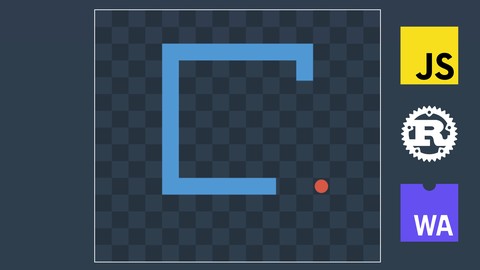
Snake Game With Rust, JavaScript, and WebAssembly
Snake Game With Rust, JavaScript, and WebAssembly, available at $34.99, has an average rating of 3.55, with 11 lectures, based on 36 reviews, and has 332 subscribers.
You will learn about Connect JavaScript and Rust with WebAssembly Game Development Basics Practical Applications of Vectors This course is ideal for individuals who are Beginner Game Developers or JavaScript Developers or Rust Developers It is particularly useful for Beginner Game Developers or JavaScript Developers or Rust Developers.
Enroll now: Snake Game With Rust, JavaScript, and WebAssembly
Summary
Title: Snake Game With Rust, JavaScript, and WebAssembly
Price: $34.99
Average Rating: 3.55
Number of Lectures: 11
Number of Published Lectures: 11
Number of Curriculum Items: 11
Number of Published Curriculum Objects: 11
Original Price: $19.99
Quality Status: approved
Status: Live
What You Will Learn
- Connect JavaScript and Rust with WebAssembly
- Game Development Basics
- Practical Applications of Vectors
Who Should Attend
- Beginner Game Developers
- JavaScript Developers
- Rust Developers
Target Audiences
- Beginner Game Developers
- JavaScript Developers
- Rust Developers
In this course, we will build a Snake Game with Rust, JavaScript, and WebAssembly. We will learn how to export API implemented with Rust to JavaScript app. We will get to know canvas rendering, applications of vectors, and basics of game development so that at the end of the course, you can take the core of this project and improve it or create your game.
Before we start writing code, we need to have a clear vision of what we are going to build. Let’s first decide on what features the game will have and how it will look like so that we can make a plan of action.
We are going to build a classic snake game that you can see on the screen. When the snake eats food, it becomes longer, and the score increases. If the snake heats the wall or bites the tail game is over. Additionally, we will allow the player to stop the game by pressing the space button. To keep the user motivated, we will save the best score and show it alongside the current one. We make sure that the game looks good on any screen size, be it a tiny mobile phone or a large TV.
We want each component of the game to be as independent as possible. We will implement the core logic of the game with Rust and will export API to JavaScript via WebAssembly.
The main thing that we will export from Rust is Game struct with a constructor and two public methods. The first method will receive a duration from the last update and direction that the user wants a snake to take. The second method will check if the game is over.
On the JavaScript side, we will run the game loop, call API methods, render all game elements, capture user input, and save the best score.
Now let’s plan how we are going to make it all happen. First, we will install the tools needed for development and start the project. Then we will create an instance of the Game struct from JavaScript. Next, we will render all the objects of the game. Then we will implement logic to place food in a random place that is free from the snake. After that, we will start the game loop and make the snake move. Next, we will allow the user to control the snake direction and stop the game. After that, we will make that every time the snake eats the food, its tail grows longer. Finally, we will complete the development of the game by adding logic that will restart the game when the player lost and deploy the game.
All the source code you can find in the repository. Each part will have a link to the corresponding commit. There are a lot of things to cover in this short course, so let’s jump in.
Course Curriculum
Chapter 1: Introduction
Lecture 1: Introduction
Lecture 2: Starting the Project
Lecture 3: Creating the Game Instance
Lecture 4: Rendering the Game
Lecture 5: Placing the Food
Lecture 6: Game Loop
Lecture 7: Moving the Snake
Lecture 8: Eating the Food
Lecture 9: The Game Is Over
Lecture 10: Deploy the Game
Lecture 11: Next Steps
Instructors
-
Rodion Chachura
Software Engineer
Rating Distribution
- 1 stars: 3 votes
- 2 stars: 2 votes
- 3 stars: 11 votes
- 4 stars: 9 votes
- 5 stars: 11 votes
Frequently Asked Questions
How long do I have access to the course materials?
You can view and review the lecture materials indefinitely, like an on-demand channel.
Can I take my courses with me wherever I go?
Definitely! If you have an internet connection, courses on Udemy are available on any device at any time. If you don’t have an internet connection, some instructors also let their students download course lectures. That’s up to the instructor though, so make sure you get on their good side!
You may also like
- Top 10 Storytelling Courses to Learn in December 2024
- Top 10 Creativity Workshops Courses to Learn in December 2024
- Top 10 Resilience Training Courses to Learn in December 2024
- Top 10 Emotional Intelligence Courses to Learn in December 2024
- Top 10 Time Management Courses to Learn in December 2024
- Top 10 Remote Work Strategies Courses to Learn in December 2024
- Top 10 Freelancing Courses to Learn in December 2024
- Top 10 E-commerce Strategies Courses to Learn in December 2024
- Top 10 Personal Branding Courses to Learn in December 2024
- Top 10 Stock Market Trading Courses to Learn in December 2024
- Top 10 Real Estate Investing Courses to Learn in December 2024
- Top 10 Financial Technology Courses to Learn in December 2024
- Top 10 Agile Methodologies Courses to Learn in December 2024
- Top 10 Project Management Courses to Learn in December 2024
- Top 10 Leadership Skills Courses to Learn in December 2024
- Top 10 Public Speaking Courses to Learn in December 2024
- Top 10 Affiliate Marketing Courses to Learn in December 2024
- Top 10 Email Marketing Courses to Learn in December 2024
- Top 10 Social Media Management Courses to Learn in December 2024
- Top 10 SEO Optimization Courses to Learn in December 2024





















